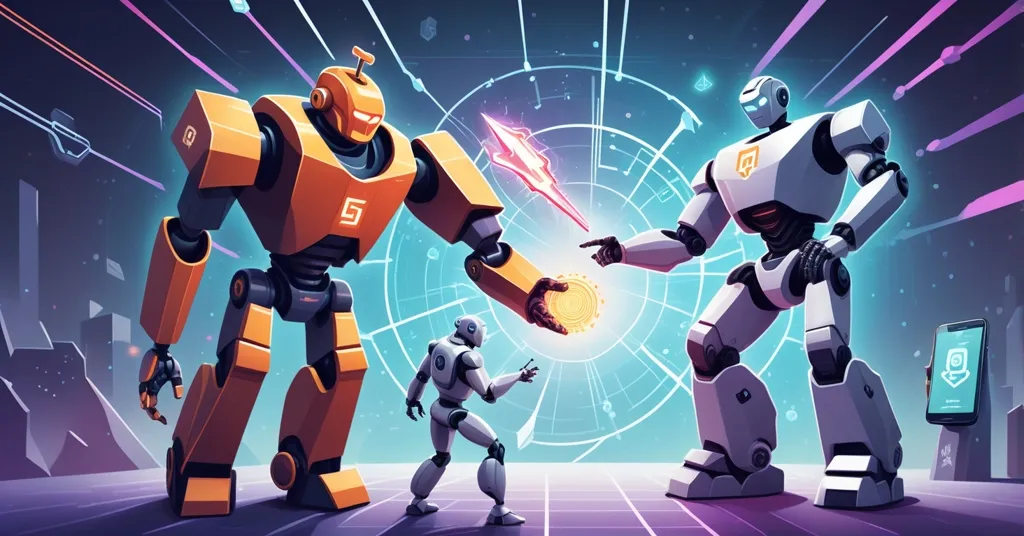Toncoin vs. Lightchain AI: Blockchain Giants Clash with Rival Strategies

Toncoin and Lightchain AI: Battling for Blockchain Supremacy with Wildly Different Playbooks
Two players in the crypto arena, Toncoin (TON) and Lightchain AI, are slugging it out for relevance, each wielding a radically different strategy. Toncoin’s banking on big-time exchange listings and a tight grip on Telegram’s massive user base to dominate DeFi and beyond, while Lightchain AI is grinding for organic cred with a tech-first, AI-blockchain mashup that’s got developers buzzing. This is David versus Goliath, with high stakes and no guarantees.
- Toncoin’s Power Move: Listings on ZondaCrypto and FameEX plus Telegram synergy fuel accessibility.
- Lightchain AI’s Hustle: Over $20.9 million raised in presales, betting on AI-driven blockchain innovation.
- Clashing Tactics: Mass adoption through partnerships versus grassroots, geek-powered growth.
Toncoin: Riding Telegram’s Massive Wave
Toncoin, often seen as Telegram’s crypto wingman, is hell-bent on becoming the go-to for decentralized finance (DeFi) and seamless digital transactions. Back in April 2024, it snagged listings on ZondaCrypto with trading pairs like USDC and TON/PLN, and on FameEX on April 11. These aren’t just vanity stats—they crank up liquidity and put TON in front of traders who’d never touch a niche exchange, as noted in recent coverage of Toncoin’s expanding reach. The real kicker, though, is its deep integration with Telegram, a messaging behemoth boasting over 900 million users. TON powers in-app purchases and DeFi services right inside the chat platform. Think buying digital goodies or staking assets without ever leaving your group chat—frictionless, user-friendly, and a potential gateway for millions of normies to dip into crypto.
But let’s not get starry-eyed. Toncoin’s Telegram tether is a double-edged sword, and it’s already drawn blood. When Telegram CEO Pavel Durov got arrested in France in August 2024 on charges tied to platform moderation—or lack thereof—TON’s price tanked 14% faster than you can say “regulatory nightmare,” with significant implications for DeFi adoption. Alex Thorn from Galaxy Digital nailed it: it’s unclear “how resilient TON can be” if governments pile on Telegram. Then there’s the not-so-small matter of a near-six-hour blockchain outage on August 28, triggered by a memecoin airdrop frenzy around something called DOGS. If a silly token drop can grind TON to a halt, what happens under a real stress test or targeted attack? Community outrage on X was palpable, with users slamming the network’s scalability issues. The TON Society fired off an open letter condemning Durov’s arrest, but passion doesn’t fix code or legal woes. History adds salt to the wound—TON started as Telegram’s Gram project, only to get slapped down by the SEC in 2020 over unregistered securities. Regulatory ghosts still linger, and TON’s fate seems handcuffed to Telegram’s operational and legal health. That’s not decentralization; it’s a damn liability.
Lightchain AI: Brains Over Brawn in the Blockchain Game
While Toncoin plays the popularity card, Lightchain AI is betting on raw innovation with an AI-blockchain hybrid that’s got the nerds intrigued. This project aims to build a developer-centric platform, merging artificial intelligence with decentralized tech. Picture a blockchain optimized for AI applications, like a gaming rig built for graphics instead of a generic laptop. They’ve already raised a hefty $20.9 million across 15 presale stages and are now in a Bonus Round with tokens pegged at $0.007, though there are valid concerns about presale risks and potential. That’s serious cash for a project with a mainnet launch still a year out, set for July 2025. Transparency is their big pitch—full GitHub repositories for protocol code, smart contracts, and AI workflows will drop at launch. Even bolder, they’ve scrapped a 5% team token allocation to fund developer grants and ecosystem incentives, signaling a “community first” ethos over quick profits.
Lightchain AI’s tech stack is where it gets spicy. They’re touting a purpose-built virtual machine and a consensus mechanism that rewards actual computational work—not just mindless math puzzles like traditional mining, but real AI processing power for tasks like machine learning or data crunching. Add in promises of low gas fees (those pesky transaction costs that spike when a network’s busy) and decentralized validator nodes, and you’ve got a blockchain that could, in theory, handle hefty AI workloads without bankrupting users, with some insights on AI-blockchain benefits shedding light on the concept. Their tagline sums up the hype:
“Ride the wave of innovation with Lightchain AI—the future of blockchain meets the power of AI.”
Hell of a pitch, no doubt, but let’s not get seduced just yet. Presales are often a crypto casino, and without third-party audits or major coverage beyond their own hype machine, this is speculative as hell. Until that mainnet goes live and the code gets battle-tested, you might as well be betting on a sci-fi flick that could flop harder than a bad Netflix sequel. Past AI-crypto projects from the 2018 ICO craze burned plenty of folks with empty promises—Lightchain AI needs to prove it’s not just another ghost in the machine.
Decentralization and Privacy: Who’s Really Championing Freedom?
Zooming out, let’s weigh these projects against the core values of decentralization and privacy we hold dear. Toncoin’s Telegram reliance raises red flags. If centralized pressures—like Durov’s arrest or future government crackdowns—force Telegram to bend, TON users could see their autonomy compromised. A messaging app with 900 million users is a juicy target for surveillance or control, and TON’s tied to that hip, a dynamic explored in its technical and historical overview. On the flip side, a win for Durov in court could rally public support and paint TON as a symbol of resistance against overreach. It’s a gamble either way, but it’s hard to call this setup a bastion of freedom when one CEO’s fate can rattle the whole chain.
Lightchain AI, meanwhile, scores points with its decentralized validator nodes and open-source push. By rewarding computational work over raw hashing power, it could distribute control more equitably than proof-of-work giants like Bitcoin in its early days. If their AI workloads pan out—say, powering decentralized healthcare models without Big Tech snooping—it might align with the privacy-first ethos we champion. But until the tech is live and audited, it’s just a pretty idea. Both projects flirt with the ideals of Web3, yet neither fully escapes the shadow of centralized risks or unproven promises.
Bitcoin Maximalist Lens: Do These Altcoins Even Matter?
From a Bitcoin maximalist standpoint, it’s tempting to shrug off both Toncoin and Lightchain AI as distractions from BTC’s mission of unassailable financial sovereignty. Bitcoin doesn’t need Telegram’s user base or AI gimmicks—it’s the bedrock of sound money, a middle finger to fiat and central banks. TON’s centralized baggage feels like a betrayal of what Satoshi envisioned, while Lightchain AI’s experimental tech risks becoming just another altcoin sideshow that dilutes focus from Bitcoin’s dominance. Yet, there’s a grudging nod to be made: TON could accelerate crypto adoption by dragging normies into the fold, even if messily, and Lightchain AI’s fusion might tackle computational bottlenecks Bitcoin won’t touch. Still, neither holds a candle to BTC’s proven resilience. Are they tools for the revolution or just shiny toys? Hard pass until they prove otherwise.
What This Means for Crypto’s 2024 Battleground
Stepping back, Toncoin and Lightchain AI mirror the split paths crypto’s taking in 2024. TON embodies the rush for mass adoption, echoing DeFi’s boom with over $50 billion locked in Ethereum protocols alone. Accessibility through platforms like Telegram is the name of the game, even if it means flirting with centralized pitfalls. Lightchain AI, on the other hand, taps the post-2022 fascination with AI-blockchain convergence, chasing scalability and real-world utility while dodging the scam stench of 2021’s meme coin madness, with a detailed comparison of their blockchain strategies highlighting the contrasts. Both face a market under the regulatory gun—Durov’s arrest is a neon sign that legal storms can hit anyone, while Lightchain AI’s transparency moves might be a shield against the scrutiny that’s torched countless tokens.
Here’s where effective accelerationism kicks in, the idea of pushing tech forward at breakneck speed to outpace legacy systems. Toncoin’s Telegram play could fast-track crypto into everyday life, flaws be damned, while Lightchain AI’s AI-blockchain gamble might be the leap needed to leave centralized tech in the dust. But acceleration doesn’t mean blind faith. The blockchain jungle chews up half-measures, and between TON’s vulnerabilities and Lightchain AI’s untested dreams, survival isn’t guaranteed. Will TON’s lifeline turn into a noose, or can Lightchain AI prove AI isn’t just crypto’s latest buzzword? The stakes couldn’t be higher.
Key Takeaways and Burning Questions
- What’s propelling Toncoin’s surge in the cryptocurrency market?
Toncoin’s momentum comes from strategic exchange listings on ZondaCrypto and FameEX for better liquidity, plus integration with Telegram’s 900 million users, enabling seamless DeFi and in-app purchases as a bridge to mainstream crypto adoption. - Why is Toncoin’s Telegram link a risky bet?
Telegram’s massive reach is a boon, but CEO Pavel Durov’s 2024 arrest caused a 14% price plunge, and a six-hour blockchain outage from a DOGS memecoin airdrop exposed scalability flaws tied to centralized dependencies. - What sets Lightchain AI apart in the blockchain race?
Lightchain AI blends AI with blockchain via an AI-native setup, offering scalability, low gas fees, and a consensus rewarding real computational work, plus developer grants and transparent code—though it’s unproven until its 2025 mainnet launch. - Is Lightchain AI’s $20.9 million presale worth the hype?
The presale haul shows investor buzz, but without audits or a live mainnet, it’s a speculative roll of the dice. Presales often mask rug pulls, so tread carefully until Lightchain AI delivers hard proof of its tech. - What do Toncoin and Lightchain AI reveal about 2024 crypto trends?
Toncoin reflects the drive for mass adoption through user-friendly DeFi platforms, while Lightchain AI embodies experimental AI-blockchain fusion, both wrestling with regulatory heat and the push for genuine utility over empty hype.



